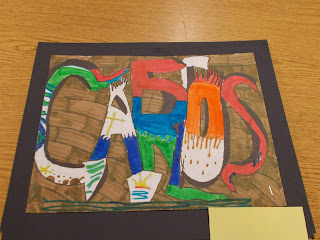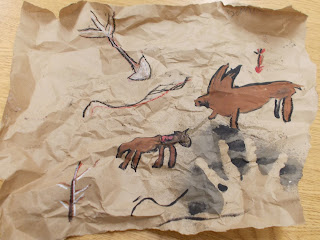"Mama"

"Mama" by my daughter age 3
Wednesday, May 1, 2013
Patricia Polacco Eggs
Van Gogh Sun Flowers
First
graders learned about the artist Vincent Van Gogh by reading the story Camille and the Sunflowers. We looked at
several paintings by Van Gogh, and we really studied his Sunflower painting!
Henri Rousseau Emphasis
*Lesson Idea inspired from Green Bay Art Room*
Graffiti Names
5th graders learned about the positives and negatives of Graffiti art. We watched part of a short video from PBS about how graffiti art has impacted the art world and how it has evolved. Students were able to use the laptop minis to experiment with different styles of graffiti from a wonderful graffiti wesbsite, www.graffiticreator.net . From their they translated their computer art into 2d art. They did awesome! Below is the link to the video.
http://www.pbs.org/newshour/art/blog/2011/03/the-history-of-american-graffiti-from-subway-car-to-gallery.html
Jim Dine Hearts
First graders learned about the
artist Jim Dine through a Power Point Presentation. They viewed several of his
paintings. They learned that Jim Dine loved to paint hearts and use bright
colors in his paintings.
First graders learned how to draw
a GIANT heart. They then outlined it with black oil pastel and used all
different colors to color in the heart. Next, they drew all different types of
lines from their heart to the edge of the paper. They then painted in the white
area between the lines with water colors.
And lastly these wonderful little
artists learned how to sew using a whip stitch. First they evenly measured out
the spots for their holes using their hands and made a mark with their pencil.
Next they used a hole puncher to punch a hole where their dot was. And lastly,
the used colorful yarn and used a whip stitch to sew all the way around their
artwork! They turned out fabulous!
Op Art
4th grade students looked a lot of examples of op art. Op art, also known as optical art, is a style of visual art that makes use of optical illusions.
Op art works are abstract, with many of the better known pieces made in black and white. When the viewer looks at them, the impression is given of movement, hidden images, flashing and vibration, patterns, or alternatively, of swelling or warping.
Can you find the hidden image in the 4th graders work?
Cave Art
2nd
and 3rd graders learned about the Cave Paintings of Lascaux, France.
In 1940, 4 teenagers were playing and knocked over tree. The roots of the tree
revealed a giant hole in the ground. The teenagers went in to explore and
discovered several underground caves all connected. The walls were covered in
ancient paintings mostly consisting of animals, figures, ancient weaponry, and
other symbols. The cave paintings are 17,000 years old!
The students
were able to visit the caves via technology. The Caves of Lascaux has a website
where it can take you on a virtual tour of all the caves. After seeing the
caves, we discussed what the cave art could mean and what these people were
trying to tell us.
We looked
closely at all the cave art. For the project students were to choose one animal
to re-draw onto their paper, they also needed to add in some ancient symbols.
They painted them, used oil pastel for details, and had their handprint sprayed
on. And lastly they got to crumple up their artwork to give it the ancient cave
art look!
Baird Elementary All School Art Show
Shrinky Dink craft Center for families to make a craft.
Post It Note Collaborative Art Installation. Art Is.....
Families then could draw a picture or write a word to describe what art is.
Subscribe to:
Posts (Atom)












































